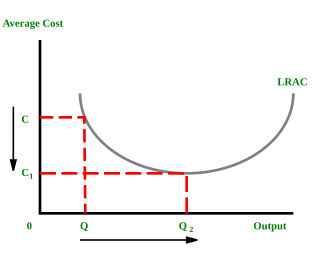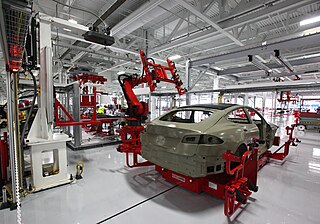Related Research Articles

In microeconomics, economies of scale are the cost advantages that enterprises obtain due to their scale of operation, and are typically measured by the amount of output produced per unit of time. A decrease in cost per unit of output enables an increase in scale that is, increased production with lowered cost. At the basis of economies of scale, there may be technical, statistical, organizational or related factors to the degree of market control.

A fuel cell is an electrochemical cell that converts the chemical energy of a fuel and an oxidizing agent into electricity through a pair of redox reactions. Fuel cells are different from most batteries in requiring a continuous source of fuel and oxygen to sustain the chemical reaction, whereas in a battery the chemical energy usually comes from substances that are already present in the battery. Fuel cells can produce electricity continuously for as long as fuel and oxygen are supplied.

Manufacturing is the creation or production of goods with the help of equipment, labor, machines, tools, and chemical or biological processing or formulation. It is the essence of the secondary sector of the economy. The term may refer to a range of human activity, from handicraft to high-tech, but it is most commonly applied to industrial design, in which raw materials from the primary sector are transformed into finished goods on a large scale. Such goods may be sold to other manufacturers for the production of other more complex products, or distributed via the tertiary industry to end users and consumers.

A supply chain, sometimes expressed as a "supply-chain", is a complex logistics system that consists of facilities that convert raw materials into finished products and distribute them to end consumers or end customers. Meanwhile, supply chain management deals with the flow of goods within the supply chain in the most efficient manner.
An electricity market is a system that enables the exchange of electrical energy, through an electrical grid. Historically, electricity has been primarily sold by companies that operate electric generators, and purchased by consumers or electricity retailers.

Lean manufacturing is a method of manufacturing goods aimed primarily at reducing times within the production system as well as response times from suppliers and customers. It is closely related to another concept called just-in-time manufacturing. Just-in-time manufacturing tries to match production to demand by only supplying goods that have been ordered and focus on efficiency, productivity, and reduction of "wastes" for the producer and supplier of goods. Lean manufacturing adopts the just-in-time approach and additionally focuses on reducing cycle, flow, and throughput times by further eliminating activities that do not add any value for the customer. Lean manufacturing also involves people who work outside of the manufacturing process, such as in marketing and customer service.

Distributed generation, also distributed energy, on-site generation (OSG), or district/decentralized energy, is electrical generation and storage performed by a variety of small, grid-connected or distribution system-connected devices referred to as distributed energy resources (DER).

A car platform is a shared set of common design, engineering, and production efforts, as well as major components, over a number of outwardly distinct models and even types of cars, often from different, but somewhat related, marques. It is practiced in the automotive industry to reduce the costs associated with the development of products by basing those products on a smaller number of platforms. This further allows companies to create distinct models from a design perspective on similar underpinnings. A car platform is not to be confused with a platform chassis, although such a chassis can be part of an automobile's design platform, as noted below.
Energy demand management, also known as demand-side management (DSM) or demand-side response (DSR), is the modification of consumer demand for energy through various methods such as financial incentives and behavioral change through education.

Operations management is concerned with designing and controlling the production of goods and services, ensuring that businesses are efficient in using resources to meet customer requirements.
Lean thinking is a management framework made up of a philosophy, practices and principles which aim to help practitioners improve efficiency and the quality of work. Lean thinking encourages whole organisation participation. The goal is to organise human activities to deliver more benefits to society and value to individuals while eliminating waste.

Demand response is a change in the power consumption of an electric utility customer to better match the demand for power with the supply. Until the 21st century decrease in the cost of pumped storage and batteries, electric energy could not be easily stored, so utilities have traditionally matched demand and supply by throttling the production rate of their power plants, taking generating units on or off line, or importing power from other utilities. There are limits to what can be achieved on the supply side, because some generating units can take a long time to come up to full power, some units may be very expensive to operate, and demand can at times be greater than the capacity of all the available power plants put together. Demand response, a type of energy demand management, seeks to adjust in real-time the demand for power instead of adjusting the supply.
A virtual power plant (VPP) is a system that integrates multiple, possibly heterogeneous, power sources to provide grid power. A VPP typically sells its output to an electric utility. VPPs allow energy resources that are individually too small to be of interest to a utility to aggregate and market their power. As of 2024, VPPs operated in the United States, Europe, and Australia.
Cellular manufacturing is a process of manufacturing which is a subsection of just-in-time manufacturing and lean manufacturing encompassing group technology. The goal of cellular manufacturing is to move as quickly as possible, make a wide variety of similar products, while making as little waste as possible. Cellular manufacturing involves the use of multiple "cells" in an assembly line fashion. Each of these cells is composed of one or multiple different machines which accomplish a certain task. The product moves from one cell to the next, each station completing part of the manufacturing process. Often the cells are arranged in a "U-shape" design because this allows for the overseer to move less and have the ability to more readily watch over the entire process. One of the biggest advantages of cellular manufacturing is the amount of flexibility that it has. Since most of the machines are automatic, simple changes can be made very rapidly. This allows for a variety of scaling for a product, minor changes to the overall design, and in extreme cases, entirely changing the overall design. These changes, although tedious, can be accomplished extremely quickly and precisely.

Production leveling, also known as production smoothing or – by its Japanese original term – heijunka (平準化), is a technique for reducing the mura (unevenness) which in turn reduces muda (waste). It was vital to the development of production efficiency in the Toyota Production System and lean manufacturing. The goal is to produce intermediate goods at a constant rate so that further processing may also be carried out at a constant and predictable rate.
Toyota Kirloskar Motor Private Limited (TKM) is an Indian joint venture between Toyota Motor Corporation (89%) and Kirloskar Group (11%), for the manufacture and sales of Toyota cars in India. The headquarters are located in Bidadi, Karnataka, near Bengaluru.

Electricity pricing can vary widely by country or by locality within a country. Electricity prices are dependent on many factors, such as the price of power generation, government taxes or subsidies, CO
2 taxes, local weather patterns, transmission and distribution infrastructure, and multi-tiered industry regulation. The pricing or tariffs can also differ depending on the customer-base, typically by residential, commercial, and industrial connections.
Lean enterprise is a practice focused on value creation for the end customer with minimal waste and processes. The term has historically been associated with lean manufacturing and Six Sigma due to lean principles being popularized by Toyota in the automobile manufacturing industry and subsequently the electronics and internet software industries.

Variable renewable energy (VRE) or intermittent renewable energy sources (IRES) are renewable energy sources that are not dispatchable due to their fluctuating nature, such as wind power and solar power, as opposed to controllable renewable energy sources, such as dammed hydroelectricity or bioenergy, or relatively constant sources, such as geothermal power.
References
- ↑ Terwiesch, Christian; e. Bohn, Roger (2001). "Learning and process improvement during production ramp-up". International Journal of Production Economics. 70: 1–19. doi:10.1016/S0925-5273(00)00045-1. S2CID 4995288.
- ↑ Toyota says to ramp up production in China. Space Mart, June 17, 2008.
- ↑ "Apple Ramps Up Production Of iPad Ahead Of The Holiday Season". 23 November 2010. Retrieved 2014-09-10.
- ↑ Bruce, Chaddus. Wrightspeed’s X1 Electric Supercar Sparks Hybrid Dreams. Wired, April 4, 2007.
- ↑ "Ramp Rate - an overview | ScienceDirect Topics". www.sciencedirect.com. Retrieved 2021-04-07.
- ↑ Hentschel, Julia; Babić, Ugljes˘a; Spliethoff, Hartmut (2016-11-01). "A parametric approach for the valuation of power plant flexibility options". Energy Reports. 2: 40–47. Bibcode:2016EnRep...2...40H. doi: 10.1016/j.egyr.2016.03.002 . hdl: 10419/187842 . ISSN 2352-4847.
- ↑ "Assessing the flexibility of coal-fired power plants". Deloitte France. Retrieved 2021-04-02.
- ↑ POWER (2019-04-01). "Flexible Operation of Nuclear Power Plants Ramps Up". POWER Magazine. Retrieved 2021-04-07.